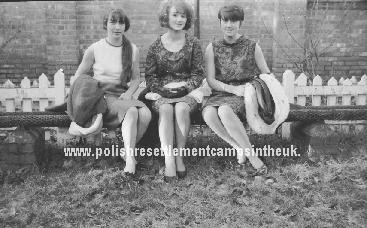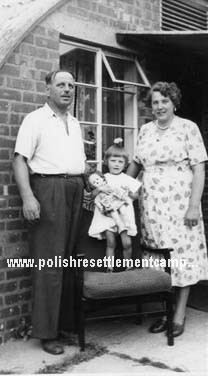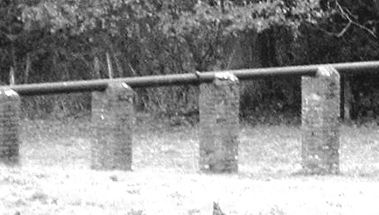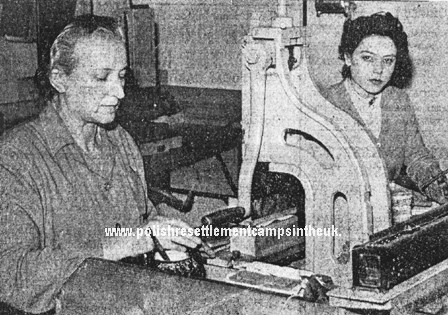|
|
| |
|
Besides the religious aspects of life in
the camp, people needed some form of entertainment and relaxation . There
was a large hall with a stage and, of all things, an orchestra pit. The
hall had many uses from hosting all sorts of performances like national
celebrations e.g. 3rd of May, Soldiers day in August, Independence Day on
11th November, Christmas nativity and other plays. It was also used for
meetings and dances. At weekends the hall converted into a cinema showing
mostly black and white westerns, war and adventure films, and a lot of
cartoons. Woody woodpecker comes to mind. There where two smaller halls in
the camp. One had a snooker table and a shop selling sweets, cigarettes
and soft drinks we called it "kantyna". The other was like a large
lounge with easy chairs, little round tables and a black and white T.V.
This was also the camp's library, with both Polish and English Books
you could take home to read. All these facilities were used as
communal meeting and relaxing areas. One must remember that in the early
days families had only ONE room to sleep, eat and live in. So these
communal areas were vital, after the trauma of war, for maintaining some
sort of normality. As military camps became home to civilians they were
renamed they became known as Hostels but we always referred to then as "Obóz"
which translates as "the camp". |
| |
 |
|
Mr.
Żbikowski with his mobile shop trading outside gate three |
|
 |
|
A view of the camp's shop. |
|
|
| |
|
For those that could not look after
themselves communal meals continued into 1960, many of the
residents were now self sufficient but living in the middle of a big country
estate with the nearest shops 2 miles away in the village of Blockley
and the nearest small town Moreton in Marsh 6 miles away and Evesham even
further, shopping for the smallest thing was a problem. |
|
|
|
To begin with
there was an enterprising Polish man with a van, nicknamed "Łysy",
(I think his name was Mr. Leon Żbikowski.) He used to trade out of his van
outside one of the gates to the camp. |
|
Selling rye bread, polish sausage,
sauerkraut, pickled gherkins and lots of other goodies. There was someone
else with a big van who traded fabrics, bedding and clothing. He came once
a week and was allowed to spread out his wares in a hall in the centre of
the camp called "ewidencja". |
|
|
|
Eventually a local shopkeeper from Blockley, Mr. Balhatchet,
opened a shop with a sub-post office in the camp. It sold general
groceries and fresh meat including live chickens. This made life a lot
more easier, as many of the residents were by now reliant on feeding
themselves and not in the communal mess. |
|
|
|
The local bus companies laid on transport once a week on Saturdays to Moreton in Marsh, Evesham and Cheltenham. These weekly shopping trips
became very popular and the busses were always full. Some two miles away
was Blockley railway station with regular services to Worcester, Malvern
and Hereford going west and Oxford and London going east. I remember my
parents taking me by train to walk the Malvern Hills and to Oxford to see
a Christmas pantomime. |
|
|
 |
|
From
left Maryla Slama. Elwira Slama, (blonde girl cannot place name) Irena
Slama in pushchair & mum Władysława aka Wanda Slama.
In the background lady sitting on one of the water pipes.
|
|
 |
|
Standing Ryszard Konopka, unknown,
Marysia Hołownia, Mrs. Konopka and Bolesław Hołownia, all enjoying the
warmth of the pipes, with the barracks and covered walk way in the
background. 1950 |
|
|
|
|
|
|
Other facilities
that the camp enjoyed was a huge coke fired boiler house situated at the
far end of gate 3 entrance , this ensured that the brick
barracks always had hot water. The water was transported in large black asbestos insulated
pipes that wound their way around the barracks supported on various sized
brick pillars, creating warm places to sit on.
|
| |
| |
|
| |
|
 |
 |
 |
|
Wanda Oko, Basia Woźniakiewicz,
and Irena Bachryj. The hot water
pipes were nice to sit on. |
Jurek Borowski by the entertainment hall |
L-R, Rysiek Busz, Michael Robb and Gienek Zdanko. |
|
| |
|
The 52 Nissen huts
on the other hand had no internal plumbing, water was fetched from strategically
placed cold water taps.
Families living in the asbestos Nissen huts not only had to put up with
the funny shaped walls but more importantly their washing and toilet
facilities were in a separate building with its
own little boiler room
in some cases up to 50 meters away. Just imagine having to walk that far,
in all kinds of weather just to fill a kettle, not to mention every time
nature
called. At the far end of a field adjacent to the
camp was a sewage farm. |
| |
 |
|
Left;- In their garden
outside their Nissen hut are Katarzyna Sklepkowicz, unknown, Zenobia Sklepkowicz, Antonina Olearczuk, Teresa Sklepkowicz. |
|
Antoni Olearczuk
later married Zenoba in Redditch. |
|
The Sklepkowiczs were at Northwick from September
1948 until December 1949 |
| |
| |
|
|
|
Right:-
Outside their Nissen hut are Mr. and Mrs. Radczak
with their daughter Alicja 1958 |
|
|
|
 |
|
| |
|
People in the camp came from every
corner of Poland and from every walk of life, from farm and factory
workers to doctors, nurses and teachers. As the camp was once a hospital
there was a purpose built sick bay, and it was now staffed by Polish
nurses and doctors, becoming very useful for residents with minor
ailments. Patients with serious illnesses were sent to a Polish Hospital
in North Wales, Hospital no. 3, in Penley. For more information about
Penley visit
this excellent BBC website. In the early days language problems made
finding work difficult. The National Assistance Board employed some people
in the camp, in catering, in the sick bay and a few with language skills
were employed in administration. Some of the men found work at the
Ministry of Defence Royal Engineer's Depot in Long Marston about 10 miles
away. Because of the distance, for many months, before daily buses were provided,
the men had to live there coming home only at week ends. My father was
one of them and during that time I only saw him once a week. |
|
|
|
In the mid-fifties life at the camp
improved. Most people spoke enough English to get by and there was plenty
of work in the area. Most men worked in Long Marston
and many others found work at Dowty in Tewksbury and
Cheltenham and Esplays in Broadway Women found work in a local canning factory Smedleys
in Evesham and Willmotts of Evesham, a case manufacturers. The Needle Industry in Studley and
Redditch also gave employment to many more, laying on buses from the camp to
the different factories. |
|
In 1955 with the co-operation of
the Ministry Labour and the National Assistance Board
Willmotts expanded it's operation by opening a unit in one of
the camp huts, this provided opportunities of
remunerative work for women with young children and some older women |
| The hostel's first
warden was English a Mr. J.Q. Evans who was very supportive of the scheme.
The camp's last warden was Polish, Mr. Juny. When the camp closed
down Mr. Juny administrated the last remaining camp Stover Park in
Devon. |
| |
|
Polish ladies making boxes in
the camp's Willmott unit. |
| |
| |
|










